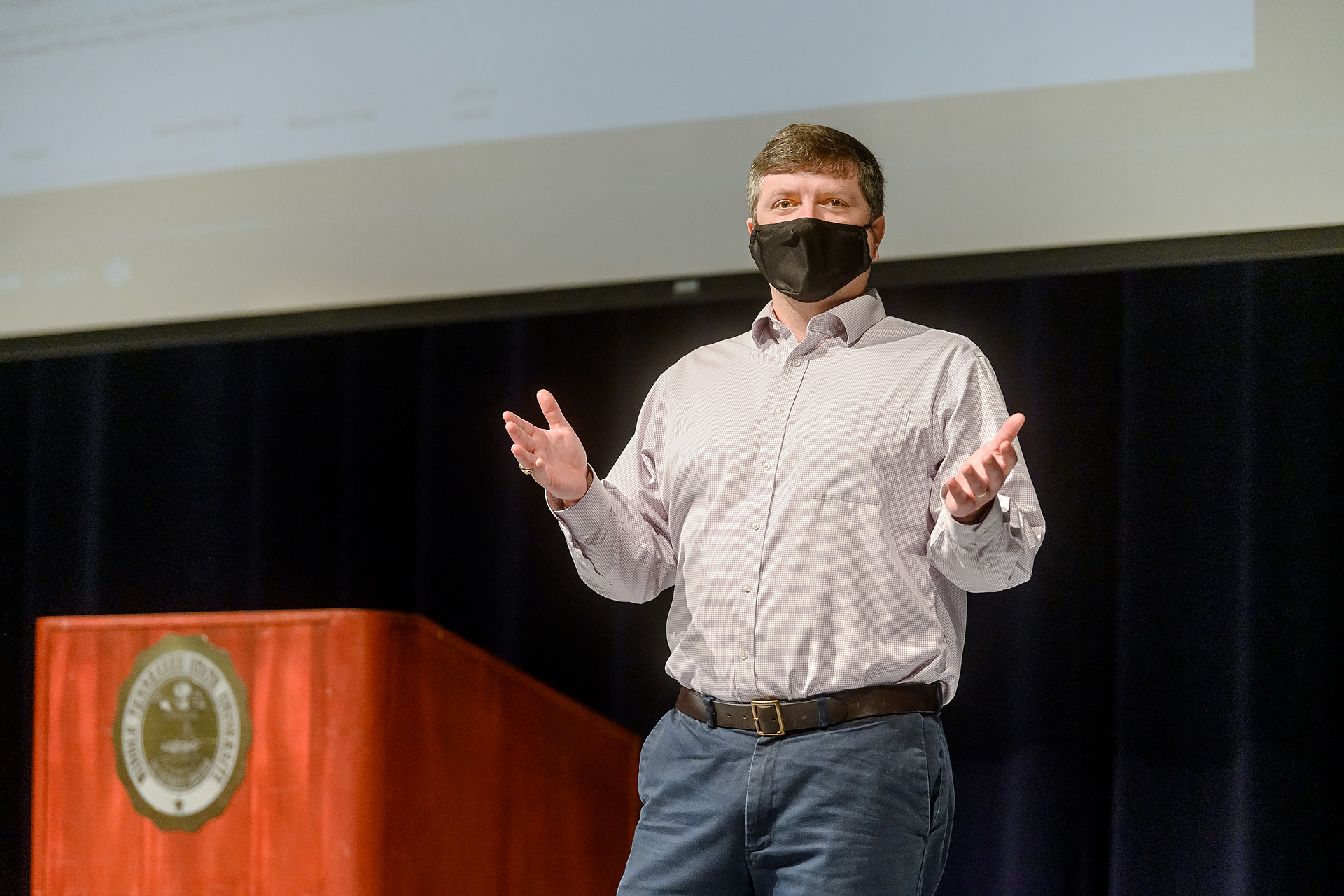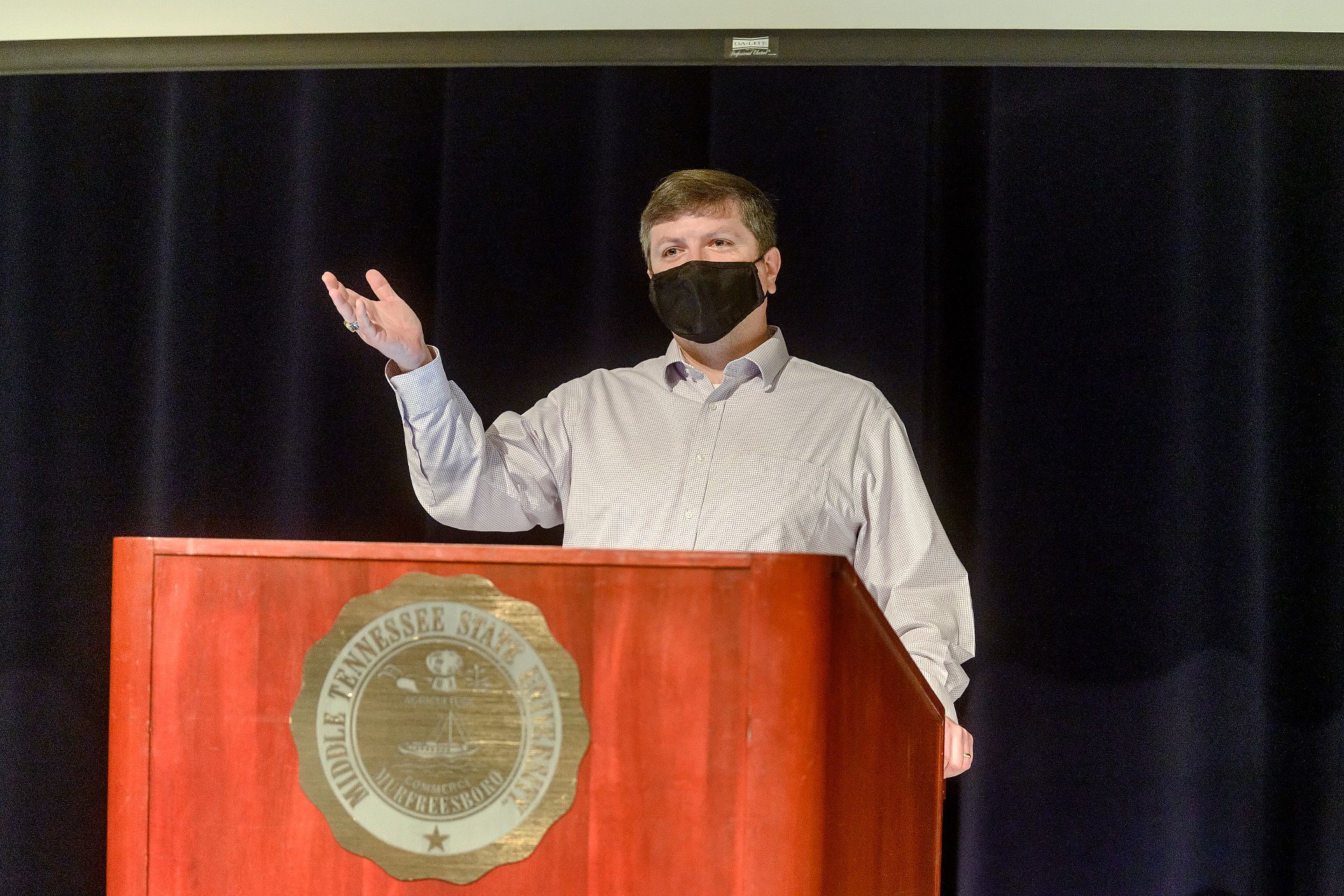Having successfully made a quick pivot to all online course delivery last spring because of COVID-19, MTSU finance professor Keith Gamble, chair of the Department of Economics and Finance, felt it was important to “prepare for all possibilities” following the university’s decision to pursue some form of in-person classes for fall 2020.
Now in his fifth year at MTSU, Gamble had already full embraced virtual technology in the development of his Finance 2010 Personal Financial Planning class, an all-online course that produced a 500% increase in enrolled students and was among courses nominated for the University’s Outstanding Achievement in Instructional Technology Award last academic year.
Gamble also offers a web-assisted section of the course that includes an in-person classroom component, but for the fall semester, he sought to maximize the flexibility for students where they could “move seamlessly” between on-ground, remote, and online instruction regardless of the section they selected when enrolling.
Gamble’s in-person section met on Monday mornings inside a socially-distanced Tucker Theatre, but he added a Zoom option for students who preferred a remote learning experience — whether live or recorded — because of health concerns or other reasons. And the fully online component of the course is still available and integrated into D2L, the acronym for the university’s Desire2Learn online learning management system for students and faculty.

Keith Gamble, Chair, Economics and Finance, Jones College of Business Director faculty profile at Tucker Theater and BAS. (Photo: J. Intintoli)
MTSU continues to follow strict health and safety protocols in line with Centers for Disease Control and Prevention recommendations and has extended a policy of mandatory masks or face coverings inside all university buildings and even outside when social distancing isn’t possible. University administration continues to closely track positive coronavirus cases among employees and students in case a pivot back to an all-virtual posture is needed.
“I really wanted to, regardless of … whether campus ends up closing or not, I wanted a seamless experience for students. I’m just going to try to provide the maximum flexibility I can,” Gamble said of his approach in setting up his personal finance course.
“So a student might show up in class the first week, then participate on Zoom the next week; show up back in class the third week, and maybe they just work with the online material the next week,” he said. “So they can kind of jump back and forth, which is something I’ve never offered in the past. I thought it fit.”
It takes a bit of multitasking.
“So when I teach in the classroom, I’m also on Zoom,” he said. “I’m looking at the chat, the things I put up on the projector and screen sharing with students. So it’s like three different delivery modes are all happening at once, and students regardless whether they’re registered fully online or the classroom experience, are there.”

Gamble’s in-person section meets on Monday mornings inside a socially-distanced Tucker Theatre, but he’s added a Zoom option for students who prefer a remote learning experience — whether live or recorded — because of health concerns or other reasons. (Photo: J. Intintoli)
Gamble applauded the university, led by the Learning, Teaching and Innovative Technologies Center, for hosting “fantastic” training sessions over the summer to help faculty with best practices for making the most efficient and effective use of virtual technology to keep the student learning experience as engaging as possible.
Gamble participated in a virtual learning group of faculty over the summer who taught some of the larger courses to share strategies and tips for providing the best learning experience for students.
“I never taught a Zoom class before this fall. So I really engaged in those training opportunities over the summer to see what other people had figured out and learned,” he said. “And I’ve just gone for it. Like, let’s make this work and it is a challenge to be in a classroom and teach in a classroom while you’re also interacting with students who are on Zoom … And so I regularly pause and look at the chat to see if there are any questions. I look for raised hands in person and raised hands on the Zoom.”
And with students facing such an uncertain environment, from school to work to home, Gamble, like other faculty, is embracing the University’s multimillion-dollar investment in technology, coordinated by the Information Technology Division, to maintain a high quality educational experience, regardless of the method of course delivery.
“I think the pressure for me is just really internally wanting to do a good job, and I love to see students succeed,” he said.
“I mean, when I missed a class in college, that was it. You’re never getting that back and had better find some notes that someone took in class. It’s a different world for our students. You can get the full class experience on online at a time of your choosing. It really is an amazing flexibility feature.”
— Jimmy Hart (Jimmy.Hart@mtsu.edu)


COMMENTS ARE OFF THIS POST